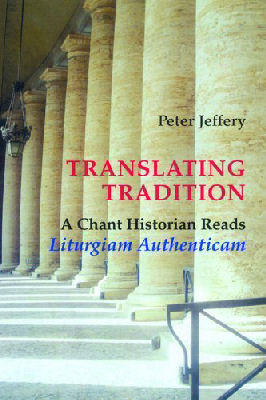
|
Posted May 16, 2006
Book: Translating Tradition: A Chant Historian Reads Liturgiam Authenticam Author: Peter Jeffery Liturgical Press. Collegeville, MN, 2005. Pp.168 An Excerpt from the Jacket:
An Excerpt from the Book: Language and Cultures Some of the problems we have with worship today arise frm the tendency to see inculturation and tradition as opposites: either one does something the traditional way, or one adapts it to a modern culture. Thus people feel compelled to take sides, favoring one over the other. Much trouble could be avoided by learning to see tradition and inculturation as two sides of the same coin, or two perspectives on the same phenomenon - for tradition is the record of inculturations past, a storehouse of models and resources for inculturations today, which in turn will generate the traditions of the future. It was possible to see this even before Vatican II, when the word "inculturation" had not yet been invented. Thus Thomas Merton could write: "There is a difference between a mystery and a dogma. A dogma of the faith is a more abstract, authoritative statement of the truth to be believed, couched in its official formulation. . .A mystery is not just the distilled and decanted formulation of a revealed truth, but that whole truth in all its concrete manifestation: in the mysteries of the faith we wee God Himself, generally in one of those great theandric actions in which He has revealed Himself to us in a concrete and tangible form. . . "To meditate on a mystery of the faith in this sense means first of all to perceive it externally as it is presented to us, as part of the Church's experience. The Church's experience of the mysteries. . . is hand down from age to age in tradition. Tradition is the renewal, in each Christian generation and society, of the experiential knowledge of the mysteries of the faith. Each new age of Christendom renews its faith and its grasp of the mystery of salvation, the mystery of man united to God in Christ, and each age renews this fundamental experience of the Christian mystery in its own characteristic way. "To enter into the mysteries of the faith by meditation, guided by the spirit of the Church, especially by the spirit of the liturgy and of Christian art, is to renew in oneself the Church's experience of those mysteries by participating in them. And of course the full participation of the Christian in the mystery of Christ is sacramental, public, liturgical: in the sacraments and at Mass. Hence the close relationship between private meditation and the public worship of the Church." This is why there can be diversity without adversity: the same incarnate Word is with us all days, making disciples of all nations. Thus the relationship between tradition and inculturation should be one of balance and discernment, avoiding the two extremes that would sacrifice one to the other: one extreme would see the local culture as a problem to be overcome on the way to thorough Romanization, which should be achieved by keeping changes in the liturgy to the necessary minimum. The other extreme would locate most of the problems in the tradition, ready to jettisom anything that makes teenagers yawn. A more reasonable and accurate view would recognize that, in the real world, culture and tradition are interconnected symbiotically. Thus for people in traditionally Christian societies, the liturgy and its arts form a major and inextricable part of cultural heritage. And in most if not all societies, cultural elements that have died out in secular life still survive in the religious celebratons of community and sacrifice, initiations, weddings, and funerals. We can see this in our own culture in such practices as "giving the bride away," which many modern women would not go through if they thought they were endorsing its original social meaning. Indeed, there is no better illustration of the inherently conservative character of liturgical worship than the strange fact that the Roman Catholic Mass (of all things) has become the last bastion of late 1960s folk-rock, long after popular music has moved on through disco, house, techno and trance, rap and hip hop. Table of Contents: 1. The Latin liturgical traditions 2. The bible in the Roman rite 3. Languages and cultures 4. Human and angelic tongues Appendix English translation of Liturgiam Authenticam |
|
